 |
Picks is a monthly sampling of Japan's art scene, offering commentary by a variety of reviewers about exhibitions at museums and galleries in recent weeks, with an emphasis on contemporary art by young artists. |
 |
 |
 |
1 November 2016 |
 |
| 1 | 2 | |
 |
|
 |
 |
|
|
 |
|
| Daisuke Takakura: monodramatic / loose polyhedron |
| 2 - 24 September 2016 |
Tezukayama Gallery
(Osaka) |
 |
| Two series by photographer Takakura, the 2014 monodramatic and the more recent loose polyhedron, reveal his roots in theater. In the former he has individual models act out specific situations, while the latter captures young subjects in their twenties and thirties -- the artist's own generation -- expressing their moods or repressed emotions. A theater actor himself, Takakura uses actors as his models, adding a tangible aura of stage performance to his compositions. |
|
|
 |
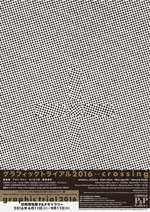 |
|
| Graphic Trial 2016 |
| 11 June - 11 September 2016 |
Printing Museum, Tokyo
(Tokyo) |
 |
| The theme of the 11th iteration of the museum's Graphic Trial series is "Crossing." While past shows have focused on the diverse expressive potential of offset printing, this one also incorporates other printing techniques like silkscreen in collaborations between printing directors at Toppan Printing Co., the museum's operator, and graphic design artists Alan Chan, Rika Eguchi, Takuya Hoda, and Minoru Niijima. |
|
|

|
 |
 |
|
 |
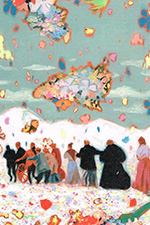 |
 |
| Sakae Ozawa: The Earth Where We Were |
| 27 August - 25 September 2016 |
Mori Yu Gallery
(Kyoto) |
 |
| In this solo show Ozawa offers paintings of various sizes and media: 18 oils on canvas and six watercolors or color-pencil drawings on paper. Among her motifs are a woman dancing amid birds crisscrossing a meadow, an ecstatic-looking woman who has merged with a craggy mountain, and a gaggle of humans and animals frolicking in a forest. The worlds Ozawa conjures -- harmonious blends of reality, fantasy, myth, and animism -- recall the sensibilities of childhood, when the real world and the world of the imagination existed side by side. |
|
|
|
|
|
|
|

|
 |
 |
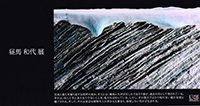 |
 |
| Kazuyo Hiruma |
| 6 - 18 September 2016 |
LADS Gallery
(Osaka) |
 |
| Ceramist Hiruma's objects consist of wafer-thin sheets of clay, layered like mille crepes in thicknesses of anywhere from several dozen to over a hundred. With titles like Memory in the Earth, Blue Memory, and Reviving: Earth, her works evoke geological strata or water brimming over sheer precipices. These phantasmic landscapes seem to give form to the eternal flow of time. |
|
|
 |
 |
| Yoshiko Naragino |
| 6 September - 2 October 2016 |
Gallery Nakamura
(Kyoto) |
 |
| Naragino is known for ceramic objects covered with relief-like ornamentation. Her fertile imagination produces colorful motifs reminiscent of the reliefs on ancient ruins, yet brimming with vitality in what can be rightly termed a paean to life. This solo show consisted of one such work on a grand scale: a three-meter diameter, two-meter high cylinder built from 360 gently curved ceramic panels. |
|

|
 |
 |
 |
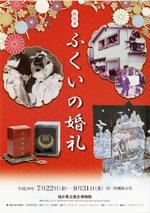
|
|
| Fukui Wedding Ceremonies |
| 22 July - 31 August 2016 |
Fukui Prefectural Museum of Cultural History
(Fukui) |
 |
| In this introduction to wedding customs in Fukui Prefecture, one learns that when the bride arrives at the groom's house, his male relatives toss dumplings -- or in some locales, sweets or instant noodles -- from the roof to the neighbors gathered below. Fukui is known for its lavish nuptials and still ranks as one of Japan's top prefectures in wedding expenses. Changes in these traditions over the past century and a half are examined, with a particular focus on the rapidly evolving practices of the postwar high-growth decades. |
|
|
 |
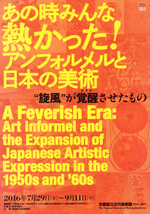 |
 |
| A Feverish Era: Art Informel and the Expansion of Japanese Artistic Expression in the 1950s and '60s |
| 29 July - 11 September 2016 |
The National Museum of Modern Art, Kyoto
(Kyoto) |
 |
| The Art Informel ("unformed art") movement arrived in Japan in the mid-1950s, where it exploded upon impact thanks in large part to the 1956 Exposition Internationale de l'Art Actuel, whose participants included such avant-gardists as Taro Okamoto and Toshimitsu Imai. This show thoroughly demonstrates the havoc the Informel whirlwind wreaked on such diverse genres as oil painting, sculpture, Nihonga, ceramics, and even Ikebana. The spectacle presented by the array of 100 works is worth a look in itself. |
|
|
|
|
|
|
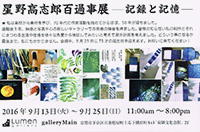 |
 |
Koshiro Hoshino: Encyclopedic Exhibition |
13 - 25 September 2016 |
Lumen Gallery, galleryMain
(Kyoto) |
 |
| Two adjacent Kyoto galleries collaborated on this retrospective of the career of veteran artist Hoshino, who turned 73 during the show. The selection of works from the 1970s on is overshadowed by the sheer volume of other materials on hand: posters, pamphlets, photos, videos, newspapers and magazines, memos and drawings fill the small exhibit space to overflowing. More than a retrospective, this is a sprawling chronicle of one individual's life and times. |
|
 |
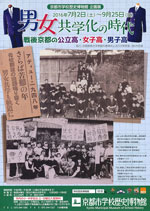 |
 |
| The Era of Coeducation: High Schools in Postwar Kyoto |
| 2 July - 25 September 2016 |
Kyoto Municipal Museum of School History
(Kyoto) |
 |
| In May 1947 Japanese middle schools became coed by dictate of the Allied Occupation Forces. This exhibit uses school newspapers, photographs, and textbooks to trace the subsequent evolution of coeducation in postwar Japan up to around 1970. Kyoto was also at the vanguard of instituting coed home economics classes, beginning with the city's high schools in 1963. Insofar as the practice was not established nationwide until 1994, Kyoto was thus a guinea pig of sorts for coeducation in Japan. |
|
|
|
|
 |
|